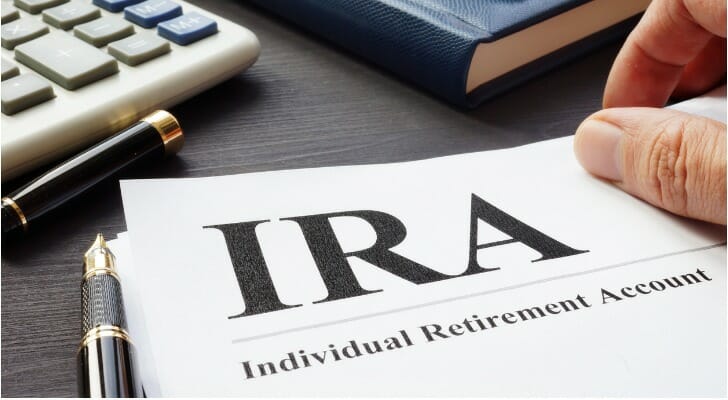Traditional IRAs and brokerage accounts are two types of investment vehicles. While IRAs help investors save for retirement in a tax-efficient manner, brokerage accounts typically offer more flexibility since they are not subject to the same rules that affect IRAs. Which one is right for you depends on your needs, goals and time horizon. Let’s analyze how to choose between the two types of accounts.
A financial advisor can help you choose between the two and determine how to invest your money to meet your financial goals.
What Is a Brokerage Account?
A brokerage account allows investors to buy and sell securities, including stocks, bonds, mutual funds, exchange-traded funds and real estate investment trusts. A brokerage is a financial institution that serves as an intermediary between investors and the markets. In exchange for processing trades and keeping custody of an investor’s assets, brokerages typically charge transaction fees and/or account fees.
Also known as a taxable account, brokerage accounts do not offer the same tax advantages that IRAs and other retirement accounts do. Instead, any capital gains, interest or dividends that an investment generates within a brokerage account will trigger a tax bill that year.
There are several different varieties of brokerage accounts, including self-directed online accounts and robo-advisors. The self-directed option allows the investor to place trades and manage their investments themselves. A robo-advisor, on the other hand, is a digital platform that uses algorithms to select and manage investments for the investor. Investors can also use stock brokers or financial advisors to place trades on their behalf within a brokerage account.
In addition to investing in traditional securities like stocks and bonds, investors can use brokerage accounts for options trading or to trade on margin using funds that are borrowed from the broker.
What Is an IRA?

An individual retirement account (IRA) is a tax-advantaged savings vehicle designed to help people save for retirement. Unlike 401(k)s and pension plans, which are administered by employers, the owner of an IRA is the one responsible for opening and managing their account. Because they exist outside of employer-sponsored retirement plans, IRAs can be opened at a bank or brokerage firm.
However, workplace plans and IRAs are not mutually exclusive. A person can contribute to both an IRA and 401(k) if they want. Depending on the type of IRA a person has, contributions can grow either tax-free or tax-deferred. This is the primary benefit of having an IRA.
Money contributed to a traditional IRA is taxed when it’s withdrawn from the account. These contributions may also be tax-deductible. Roth IRAs, on the other hand, are funded with after-tax dollars, which means a person won’t owe any taxes on the money when they begin taking withdrawals.
When it comes to individual investments, an IRA can hold a wide range of securities, including stocks, bonds, mutual funds, exchange-traded funds and other securities.
Brokerage Account vs. IRA: Contributions and Withdrawals
The main differences between these two investing vehicles are the rules that surround how money is contributed and withdrawn from either account. While the IRS imposes strict rules and regulations for IRAs, brokerage accounts are not subject to the same stipulations, making them much more flexible.
First, the IRS caps how much you can contribute to an IRA in a given year. The annual IRA contribution limit in 2026 is $7,500 ($8,600 for people 50 and older). No such limit exists for brokerage accounts.
Second, since IRAs are designed to help people save for retirement, money typically cannot be withdrawn from an account before a person reaches age 59 ½. Early withdrawals trigger a 10% penalty, plus income taxes that are due for traditional IRAs. There are also required minimum distributions (RMDs) to consider. Money can’t remain in an IRA forever.
Starting at age 73 (age 75 for people born in 1960 or later), the owner of an IRA must begin taking a minimum distribution from the account each year. None of these requirements apply to a brokerage account. Instead, money can be withdrawn as early and often (or infrequently) as the investor chooses.
Finally, not everyone can take advantage of the unique tax benefits that IRAs offer. The tax deduction attached to traditional IRA contributions phases out at a specific income threshold, which varies based on a person’s tax filing status. In 2026, single filers who make over $168,000 and joint filers who earn more than $252,000 are ineligible to contribute directly to a Roth IRA.
Married couples that file jointly may deduct their full contributions to their traditional IRAs regardless of income if neither is covered by a workplace retirement plan. However, if one or both spouses have access to an employer-sponsored plan, their income will dictate whether or not they can deduct those contributions.
| Filing Status/Situation | Full Deduction Allowed | Partial Deduction Allowed | No Deduction Allowed |
|---|---|---|---|
| Single, covered by a workplace retirement plan | Up to $81,000 | $81,000 – $91,000 | Over $91,000 |
| Married Filing Jointly (spouse making the contribution is covered by a workplace plan) | Up to $129,000 | $129,000 – $149,000 | Over $149,000 |
| Married Filing Jointly (contributor not covered, spouse is covered) | Up to $242,000 | $242,000 – $252,000 | Over $252,000 |
| Married Filing Separately, covered by a workplace plan | N/A | $0 – $10,000 | Over $10,000 |
While there are no income or contribution limits for brokerage accounts, there are no tax benefits associated with them. Additionally, brokerages may require a minimum balance to open an account.
Brokerage Account vs. IRA: Taxes

Another primary difference between brokerage accounts and IRAs is how they are taxed. As mentioned above, brokerage account owners are responsible for paying taxes on any capital gains realized in a given year, as well as any interest income or dividends they collect. IRA accounts, however, are not subject to capital gains taxes. Instead, withdrawals from IRAs are taxed as ordinary income.
For brokerage accounts, any capital gains realized are subject to either short- or long-term capital gains tax rates. While the former applies to securities that are sold less than a year after they are purchased, the latter applies to securities that are held for more than a year before being sold.
Short-term gains are taxed as ordinary income. However, long-term gains receive a more favorable tax treatment and are subject to either a 0%, 15% or 20% tax rate depending on how much income the investor reports in a given year.
2026 Long-Term Capital Gains Tax Rates
| Tax Rate | Individuals | Married Filing Jointly | Head of Household | Married Filing Separately |
|---|---|---|---|---|
| 0% | $0 – $49,450 | $0 – $98,900 | $0 – $66,200 | $0 – $49,450 |
| 15% | $49,450 – $545,500 | $98,900 – $613,700 | $66,200 – $579,600 | $49,450 – $306,850 |
| 20% | $545,500+ | $613,700+ | $579,600+ | $306,850+ |
As for traditional IRAs, all taxes are deferred until money is withdrawn. That means any capital gains, interest income or dividends that investments generate within an IRA are not taxed immediately. This allows investment earnings to compound over time without taxes reducing the size of the portfolio. However, once money is withdrawn from an IRA, the distributions are taxed according to the investor’s income tax bracket.
When to Use an IRA?
Saving for retirement with an IRA, 401(k) or another employer-sponsored plan typically should take priority over investing in a brokerage account. The earlier a person starts saving for retirement the longer their money has to harness the power of compound interest and grow.
If you’re not covered by a workplace retirement plan, saving in an IRA every year is even more important. After contributing the maximum amount to your IRA ($7,500 in 2026), you may want to consider depositing any leftover money in a brokerage account and investing it from there.
People who have access to an employer-sponsored retirement plan may also consider opening an IRA, which typically offers a greater selection of securities than 401(k) plans. If your employer offers a company match, consider contributing enough to your workplace plan to qualify for the match and then direct excess funds to your IRA.
Another thing to consider: transactions within IRAs are not immediately subject to taxes. That means you won’t owe taxes each year on any dividends and mutual fund distributions that your portfolio generates. For example, if you own an income mutual fund that invests in dividend stocks, you won’t have an annual tax liability associated with those dividends. The same goes for actively managed mutual funds with high turnover or other securities that produce lots of transactions.
When to Use a Brokerage Account?
As mentioned earlier, using a brokerage account can be an especially effective way to invest and save for a short- or intermediate-term goal like buying a house. Since contributions to IRAs and other retirement accounts can’t be withdrawn without penalty before age 59 ½, these savings vehicles are much less flexible than brokerage accounts.
Yet, brokerage accounts can also be used for achieving long-term goals like retirement. After maxing out an IRA or 401(k), you may consider depositing extra money into a brokerage account and investing it for the long run. Since brokerage accounts are not subject to RMDs, money can remain invested in the account for your entire life, making them potentially valuable components of an estate plan.
Also, if you prefer to invest in more sophisticated securities like derivatives, a brokerage account is where you can do it. Brokerage accounts may also come with added features, like access to a sweep account or cash management account (CMA). A sweep account transfers uninvested cash to a high-interest investment option. Cash management accounts can allow you to earn interest on money that you plan to invest, while also providing check-writing or debit card access.
Bottom Line
Brokerage accounts and IRAs serve different investment purposes. IRAs are dedicated to retirement savings with tax advantages, such as tax-deferred growth in traditional IRAs, where taxes apply only upon withdrawal. In contrast, brokerage accounts offer greater flexibility for various financial goals but lack these tax benefits.
Tips for Becoming a Better Investor
- A financial advisor can offer investment advice or manage your portfolio on your behalf. Finding a financial advisor doesn’t have to be hard. SmartAsset’s free tool matches you with vetted financial advisors who serve your area, and you can have a free introductory call with your advisor matches to decide which one you feel is right for you. If you’re ready to find an advisor who can help you achieve your financial goals, get started now.
- Asset allocation and asset location are important fundamentals to consider when creating an investment strategy. Asset allocation refers to how you spread your money across various types of investments: equities, bonds and cash. SmartAsset’s asset allocation calculator can help you determine a mix that’s suitable for you.
Photo credit: ©iStock.com/Eva-Katalin, ©iStock.com/designer491, ©iStock.com/Edwin Tan,
